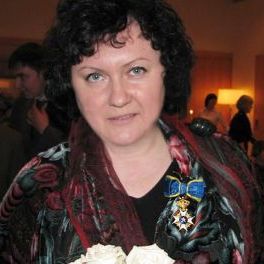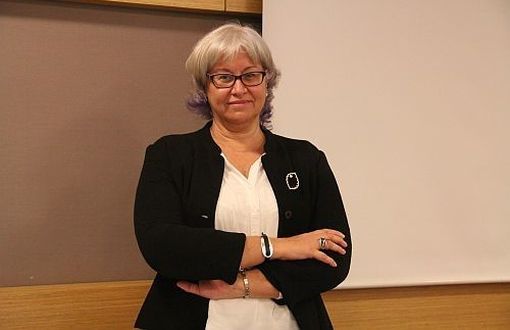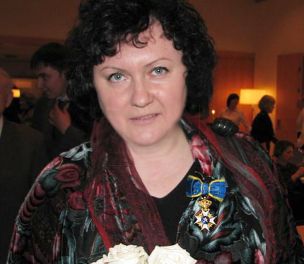I met Sevda first in İzmir, at a small conference, or workshop of journalists. She was a host and moderator of the event of Trans-Caucasus Peace Dialogue of media professionals, an initiative of two colleagues, from Armenia and Azerbaijan. It was in 2008. One of the organizers, an Azeri colleague, was my university mate, we had some common friends.
Some participants of the dialogue became friends, and this fact played a very important role in the whole initiative. The dialogue also included journalists and media experts from Turkey and Russia, reporters and editors from Karabakh, Abkhazia, and it was very vivid and deep professional and personal exchange and communication.
At that time I already had some experience in professional conversations beyond conflicts, together with colleagues from our Association of Women Journalists we arranged a couple of conferences of women in the media together with women in the media from the former USSR and former Yugoslavia, I did know how hard it was and what the role of the moderator and the host was.
I was deeply impressed with the event as a whole, its fantastic atmosphere and with Sevda’s professionalism and manner, respected everyone and at the same time followed her own way of discussion. She was dedicated to the idea of peace journalism, to the role of journalists not only reporters but those who promote ideals of peace and peace communication, because it was a way to the future.
It was very close to my understanding and understanding of the International Federation of Journalists (I was a member of the IFJ gender council at that time) that journalism is a public good. And she was interested in gender issues in the media, like me. So I found that we maybe were people of the same blood despite the fact that she was first of all a scholar, professor and I was first of all a journalist.
We established communication. I was happy to invite Sevda to Russia, to Media Festival in Sochi and to the international conference on media development arranged at Moscow State University. Sevda made very strong talks, and colleagues and scholars were impressed, both with her deep analysis of gender theory and Turkey’s media reality, which was not very well known in Russia.
In 2013 I was elected Vice President of the European Federation of Journalists (EFJ) and visited İstanbul several times as an EFJ representative. Our friendship was accompanied by professional exchange all the time, and the idea of gender and peace project was born during our conversations. This idea became more framed after our participation in OSCE events on gender equality in Vienna.
This year I was happy to meet Sevda in Dubai, at Fetisov Award Ceremony. Sevda is a member of the expert team of the award, which united the most prominent media experts from all over the world. And the main aim of the award is the promotion of journalism as a public good, journalism that illuminates the truth and our universe. I am happy that we work together again. And I do believe that the project on women journalists as peace communicators will start in the nearest time.
Importance of gender issues in the media
You work on gender issues in the media for a long time. How could you define the main trends? Why is it so important today?
When the issue is position of the women in/by mainstream media, all the problems we knew continue to be valid although there is slight progress in different cultural and political, geographies. On the one hand, discrimination against women in the media sector through the glass ceiling, wage gap, high unemployment rate, unequal job division, such as expecting “soft news” from women journalists, etc. “Symbolic annihilation” of the women with the term of George Gerbner (1976) and Gaye Tuchman (1978) and in the sense of miss/less and stereotypical representation of women, on the other hand.
The profession remains to be ruled by patriarchal principles and “ethics” as it was born, and we keep seeing its outcomes in different genres of the mainstream media. Although there are more women currently in the sector and in decision-making positions, the attempts to change the journalism and working principles of the newsrooms are still met by even female professionals’ resistance.
Briefly, women journalists made significant contributions to journalism and newsrooms practices by learning from each other’s and particularly alternative media’s experiences and taking the second wind of feminist movements at their back, but “symbolic annihilation of women”, discrimination in the newsrooms, the masculine discourse of the news reporting still continue to be an issue.
Thus, even in the countries where number of the women journalists in the newsrooms reaches at least half, we observe no meaningful progress in the above depicted picture and that makes us question the “gender issue in the media” from a different angle.
Women's impact on the global media landscape
Women have changed the global media landscape since the last decade of 20 the century, covering conflicts, top politics, investigations, and issues that used to be totally " male territory". What was the most important of this intervention by women?
Yes, although above not a bright picture is given, women journalists did a lot of changes in the profession from the very beginning of their presence in the andro-centric newsrooms where they were not welcome and/or marginalized. For instance, the issues that are considered as “domestic” and neglected for a long time by male journalists, were brought to the public attention for the first time by women journalists.
Through insistingly reporting on issues like not only child raising and education, elderly care, health, house economy, and unwaged women labor, but also taboo issues of the private sphere such as male violence towards women, incest, and marital rape, women journalists are expanded definition of newsworthiness of conventional journalism. Their tendency of using more women as news sources or as “primary news definers”, changed the framing and wording of political, economic, environmental, and most importantly so-called “domestic issues”.
Thanks to the influence of consciousness-raising actions of the women’s movement in Turkey where femicide cases used to be titled “honor killings”, “passion crime” or more recently “domestic violence”, “woman murder” are displaced by “male murder” since the previous ones either legitimizing the violence or hiding the perpetrator and there is not a word such as femi(ni)cide that refers system(at)ic character of the male violence towards woman, in the language.
Last but not least, female journalists tend to practice more peace journalism than war journalism in conventional news media although it happens mostly because of their presence not on the front but in the hinterland which enables them to report more harms of the war on most vulnerable segments of the society such as women, poor, elderlies, instead of turning their reporting into a “winners versus losers” sort of reporting.
Leaving aside the question of if an increased number of women journalists and editor’s in-chiefs etc. could also make changes in the andro-centric newsroom practices for a moment, we should underline the importance of all these contributions, but must also emphasize the need for more structural interventions.
Women's journalism as a new phenomenon
Scholars all over the world study women’s war reporting, trauma reporting, and journalism of participation. Do you agree that we can talk about women's journalism as a new phenomenon? Women are associated with peacebuilding - and peace journalism. How could you define peace journalism?
This is a long debate in academia and since the 70s, particularly the feminist media scholars, while questioning the conventional journalism of masculine newsrooms have been also researching if women journalists’ news values and practices are different or alternative to the hegemanic ones.
But the results are controversial and made the alternative presence of “women’s journalism” debatable. As I argued and exampled above, women made significant changes in the news, including the ones reported from the war zones. Some research even says, particularly through focusing on not the end, but the process and contextualizing, following up the case, and being solution-oriented and proactive, women’s news get closer to peace journalism during times of conflict as opposed to the standard journalism that triggers the war.
But these changes or claimed differences are still far away from replacing conflict-provoking codes and principles of journalism. So, my answer to the question of if female journalists are tended to be more peace journalism oriented as it has been argued by prominent names of the peace journalism theory, is no, with the following reasons.
Firstly, not the gender per se but internalized “professional ideology” of journalism, and secondly, self-censorship-based, competitive, market-driven malestream structuration of the newsrooms determine the practice. Here let me clarify a bit how the professional ideology of journalism is working for instance through the hypocritical claim of “objectivity."
As feminist news criticism puts it; “the objectivity myth” was the invention of the male-dominated newsrooms of print media of the late 19th century in the West and was elaborated within the frame of positivist epistemology that gives an omnipotent status to the Hu/man’s reason and his ability about “knowing/telling the truth”.
Thus the news was developed into a "rational", "objective", and "trustworthy" —as man expected it to be—construction of reality and within this frame of mind, it is believed that "the truth" can be known empirically and mirrored by the journalist from an independent stand although we know from the practices that is all about a lip-service.
Besides being an ideological cover over the biased coverage, the so-called objectivity claim excludes and marginalizes women’s “wor(l)ding” in journalism that is categorized as irrational, emotional, and unreliable although what we need is an “honest subjectivity” if I borrow the word of one of my interviewee.
If I sum up by considering the results of several research studies including mine that compare newsroom experiences and journalistic values of women journalists in Turkey and Greece; not the gender but the world view of the journalist is a matter for peace journalism.
So, my answer to your question is; there is no new phenomenon like “women journalism” at least in the mainstream media and in the sense of re-defining professional codes and ethics of war-provoking journalism, although hegemanic journalism has learned a lot from female journalists and the feminist alternative news media.
But I should also add, the pro-peace worldview of the journalist and her/his honest subjectivity that put not “ours” but the “others” at first, would not always guarantee better journalism or journalism for peace.
Peace journalism
How do you define peace journalism and what do you expect from its implementations?
Here, first I will try to clarify more the reasons that turn mainstream journalism into war or conflict-provoking journalism. The Conflicts in society are multiple and inescapable. If they are not fairly solved, more are triggered, and the peace is threatened. We know news media loves conflicts as its motto for newsworthiness “if it bleeds it leads” proves.
If this definition of the news value remains as it is; If the news sources, who are mainly male “definers” of the coverage, are continued to be political, economic, military power holders and the officials; if the wordings are based on (“innocents”, “victims” of) “us” versus (“evils”, “criminals” of) “them” sort of binaries and the coverages about “who was the first throw the stone” and “how many were killed” sort of “cause and effect” reasoning continue; if reporting multiple faces of the “facts” are diminished to answers of 5 W questions; if the journalists lost or hide their empathy under the cover of never-applied objectivity and not watch over the rights violations of fragile segments (“others”) of the society such as women, elderlies, kids, refugees, poor, etc., the journalism provokes more conflict.
Normative theory of peace journalism and its practices instead give us proactive journalism with insights and tools for solving the conflicts peacefully or at least not activating them. So, peace journalism is about, reporting any sort of tension, conflict, or multiple hostilities without inciting violence and towards establishing and sustaining just peace within the framework of "the other"-centered ethics. What needs to be re-emphasized in this definition here; is the suggestion of a new ethics that gives priority to the rights of others with an “honest subjectivity”.
The internet and the gender gap in the media
The Internet was expected to be the real tool of democratization and equality of the media, in the 90th many had a hope that the gender gap in the media will not exist in the global kingdom of the Internet. But infect it became a territory of aggression, sexism, hate speech and new forms of discrimination, every 3rd women in the median of the world faced cyberbullying, based on gender. What is your prognosis about the future of online journalism for women, what new platforms they could use to realize their ambitions and talents?
Digital technologies are converting our life practices, but I think we attributed a lot to them in terms of changing our minds! On the one hand, it is only a new venue to the old dominancy. As you said, women now are subjected to new forms of sexism, violence, aggression etc. They found out, AI robots, started to speak even among each other with hate speech and with the same masculine tones.
It is because whatever exists in daily life, the digital world has a replica of it and perhaps by being more influential and varied. When it comes to journalism, all the old bad habits of the profession are there as well and even worst, because of the breathtaking speed for catching the last split-second news, more news sources, more competition, and exploitation etc.
On the other hand, by having a friendly face as well, digital technologies give more freedom and better opportunities to women journalists. For instance, it allows women journalists to break the malestream news media’s editorial, spatial, physical, and even to some extent budgeter limitations. I also think, the new textual experience offered by the digital, is more woman-friendly since it is not linear, or nonhierarchical and gives space open to each other with the online environment full of and alternative media.
Gender-sensitive news reporting in Turkey
Journalists' culture and traditions are different, despite the global trends in media development. What can you tell about women journalists in Turkey, their role in the profession, in gender discussion? What trends in women's journalism do you see on a global scale?
Perhaps it would not be representative alone, but I may give an example from Turkey. In the late 90s, a group of women journalists from the 68 generation initiated an auto-control mechanism for gender-sensitive news reporting in Turkey’s most circulated paper of the time, and with the support of the owner’s daughter in the administration. They succeed to change the wording and framing of the news regarding male violence towards women; they set nationwide campaigns to stop “domestic violence” and educate the girls from rural areas; they push the editors to stop the use of “3rd-page beauty” that imitates the British yellow press of the time; they forced the administration to kick out a harasser from the paper etc. But after a while, they were discouraged, then lost the support of the women admin and finally their initiation dimmed down, due to resistance from male peers who claimed about they “dare to set a second paper in the paper” by feeling their power under threat. No need to mention that things are worst now in Turkish media from the gender point of view too, including this paper of Hürriyet due to the current “media regime”.
About Sevda Alankuş
Sevda Alankuş graduated from Faculty of Political Sciences, Ankara University, got her Ph.D degrees from the same university and in the field of Public Administration and Political Science. She has gotten her full professorship degree in Communication Sciences and has been teaching and administering at several faculties of communications at Turkish Universities. She has continued her academic works at Leeds University (United Kingdom) and Keyman Institute of Northwestern University and currently working as the dean of the Faculty of Communication at Yaşar University. Since 2000 she has been advising the BIA journalism trainings and she is the editor of 9 books in journalism and author of Peace Journalism Handbook. Her research field and publications cover issues of gender and media, feminist media criticism and ethics, journalism theories, alternative media, and peace journalism. Since 2020 she is a member of the expert consul of the Fetisov Journalism Awards.
About Nadezhda Azhgikhina
Nadezhda Azhgikhina had her B.A and Ph.D degrees from Moscow State University, Faculty of Journalism and worked for Ogonyok, Nezavisimaya Gazeta, Business Tuesday as a reporter, columnist, and editor. Currently, she is working at "Media Group" and "The Nation", besides having several professional affiliations such as being co-chair of the Fetisov Journalism Awards' steering committee, executive director of PEN Moscow, member of GAMAG Europe, president of Woman Journalist Club and member of Article 19 board. She is co-founder and co-chair of The Association of Women Journalists (2013-2019) and was vice-president of the European Federation of Journalists (2013-2019).
She taught journalism at Moscow Technological University, and Moscow State University and has been at Barnard College, Columbia University, and Tampere University as guest lecturer. As the Member and coordinator of Russian and International Research Projects run and took part in several projects on issues of gender, human rights, the safety of journalists, and press freedom under the umbrella of UNESCO, IFJ, EFJ, OSCE, MSU, UN Women, WHO, ILO, CoE. Her works is awarded by Swedish "North Star" order, Armenian Dink medal and several national organizations. She is the author of 3 books of fiction, 7 books of non-fiction and director of 2 documentaries.
She was married to Yuri Petrovich Shchekochikhi, a famous investigative journalist who wrote and campaigned against organized crime and corruption in Russia and was subjected to a politically motivated assassination in 2003 with the symptoms of radioactive poisoning.
(NA)






